|
Paper Plate Education
"Serving the Universe on a Paper
Plate"
Transit of Venus: June 8, 2004

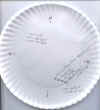 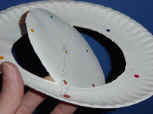
For
images of the 2004 transit of Venus, see www.transitofvenus.org/history/2004
A
transit of Venus --the movement of the planet across the disk of the
sun--was well underway on June 8, 2004, when the sun
rose in
the eastern United States. Observers saw the waning minutes of the
transit, the third and fourth contacts, the “black drop” effect, and other
rare spectacles. Other
parts of the world saw the complete transit, start to finish. Transits
drive the search to determine our place in the cosmos, from historic expeditions to quantify
solar parallax to NASA’s upcoming Kepler mission to discover
earth-class planets around distant stars.
This 2004 highlight
was an excellent opportunity for the education
community in multiple disciplines.
Caution: You may safely view the
next transit of Venus only
if you use
proper solar filters or a suitable indirect viewing technique. Do not stare at the sun without proper filters, even
at sunrise or sunset, for irreparable eye damage may result.

 As an
observational event, the 2004 transit was only moderately demanding. As seen from the eastern United
States, the
latter portion of the transit became visible at sunrise and lasted less
than an hour. This required
protective eyewear and telescope filters, a low horizon to the east-northeast,
and clear skies. The chart at left shows the hour
after sunrise as seen from the Great Lakes region (Venus not to scale). For
more sunrise photos see http://www.transitofvenus.org/gallery.htm. Sunrise
picture courtesy of Rick Pirko. As an
observational event, the 2004 transit was only moderately demanding. As seen from the eastern United
States, the
latter portion of the transit became visible at sunrise and lasted less
than an hour. This required
protective eyewear and telescope filters, a low horizon to the east-northeast,
and clear skies. The chart at left shows the hour
after sunrise as seen from the Great Lakes region (Venus not to scale). For
more sunrise photos see http://www.transitofvenus.org/gallery.htm. Sunrise
picture courtesy of Rick Pirko.
Times for third and fourth contact, listed
by city name, indicate when Venus touched the inside edge of the sun as it
left the solar disk (third contact) and when Venus touched the outer edge of
the sun after it had left the solar disk. Times are in Universal Time
(UT). Subtract 5 hours to get Central Daylight Time (CDT) or Eastern
Standard Time (EST); subtract 4 hours to get Eastern Daylight Time
(EDT).
 A recommended viewing tool
was Gene Zajac’s
modified version (see 1999 GLPA Proceedings) of a Sun
Gun by Bruce Hegerberg. The device safely allowed a crowd of
spectators to view a large projection of the sun, the transiting planet, and sunspots.
At left, Gene Zajac and Clyde Simpson easily track sunspots.
A recommended viewing tool
was Gene Zajac’s
modified version (see 1999 GLPA Proceedings) of a Sun
Gun by Bruce Hegerberg. The device safely allowed a crowd of
spectators to view a large projection of the sun, the transiting planet, and sunspots.
At left, Gene Zajac and Clyde Simpson easily track sunspots.

 During the transit,
one could track
the path of the planet's disk as it glided across the sun, as Jeremiah Horrocks did for the first recorded transit of Venus in 1639. See the Transit
of Venus activity. During the transit,
one could track
the path of the planet's disk as it glided across the sun, as Jeremiah Horrocks did for the first recorded transit of Venus in 1639. See the Transit
of Venus activity.
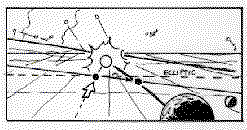 In the current epoch, transits of Venus generally occur in pairs--eight years apart--that are
separated by over a century. Astronomy author and illustrator Jay
Ryan described the circumstances that create periodic
transits, reprinted here with his permission.
In the current epoch, transits of Venus generally occur in pairs--eight years apart--that are
separated by over a century. Astronomy author and illustrator Jay
Ryan described the circumstances that create periodic
transits, reprinted here with his permission.
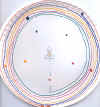
 The Transit
Frequency activity illustrates the irregular periodicity of transits. In this paper plate model, daughter Venus and
her mother Earth race around the sunny front door of a house. Out of
shape mother jogs until either daughter runs by her five times, or mother runs
eight laps around the house, whichever comes first. It's a photo
finish! Who gets back to the starting line first, daughter Venus or mother
Earth? The Transit
Frequency activity illustrates the irregular periodicity of transits. In this paper plate model, daughter Venus and
her mother Earth race around the sunny front door of a house. Out of
shape mother jogs until either daughter runs by her five times, or mother runs
eight laps around the house, whichever comes first. It's a photo
finish! Who gets back to the starting line first, daughter Venus or mother
Earth?

 June 8,
2004. In a rare alignment, Venus passed directly between earth and
the sun while Mercury was elsewhere on the inside track.
June 8,
2004. In a rare alignment, Venus passed directly between earth and
the sun while Mercury was elsewhere on the inside track.
No one is known to have seen the 1631 transit, the first in the era of the
telescope, though Pierre Gassendi apparently tried. Jeremiah Horrocks and
William Crabtree are the only two known astronomers who saw the 1639 transit, a
first in recorded history. Their interest paralleled the astronomy
community's pursuits of the day, which were more about determining the
planets' apparent sizes than distances. Young Horrocks had noted a
discrepancy between Philip Van Lansberg's oft-wrong astronomical
tables which predicted a 1639 transit and Johannes Kepler's
usually-reliable Rudolphine tables which did not. Based on his own
calculations, Horrocks correctly predicted the transit circumstance and
witnessed the last half hour of the sunset event.
In 1677 Edmond Halley proposed worldwide
expeditions to time a transit of Venus to quantify the
distance (known as an astronomical unit, or AU) from the sun to the earth.
Global
efforts to time transits of Venus occurred for the 1761/1769 and the 1874/1882
transit pairs.
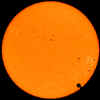 During
the transit, look
for the infamous “black drop" effect at third contact, when the disk of
Venus just touches the edge of the sun and begins the planet’s apparent egress
from the sun. Near contact a
meniscus appears between the planet and the sun, and circular Venus briefly
elongates. Ultimately reducing the
accuracy of the timing, the “black drop" effect becomes the limiting factor
in determining the Astronomical Unit via transit timings. During
the transit, look
for the infamous “black drop" effect at third contact, when the disk of
Venus just touches the edge of the sun and begins the planet’s apparent egress
from the sun. Near contact a
meniscus appears between the planet and the sun, and circular Venus briefly
elongates. Ultimately reducing the
accuracy of the timing, the “black drop" effect becomes the limiting factor
in determining the Astronomical Unit via transit timings.


 To
simulate the "black drop" effect, almost pinch your thumb and
forefinger together against a bright background. Near contact the meniscus
between them appears. To
simulate the "black drop" effect, almost pinch your thumb and
forefinger together against a bright background. Near contact the meniscus
between them appears.

 Venus passes between the sun and
earth (far left); the path of Venus is predicted for the 1761 transit (left); from Johann Doppelmayer's Atlas
Coelestis, 1742. Venus passes between the sun and
earth (far left); the path of Venus is predicted for the 1761 transit (left); from Johann Doppelmayer's Atlas
Coelestis, 1742.
 The Kepler mission
will search for earth-class planets around distant stars by detecting the
repeated dimming of the star that can be attributed to a transiting
planet. Make a paper
model of the spacecraft, access images
and animations, and find educational material at the Kepler
mission website.
The Kepler mission
will search for earth-class planets around distant stars by detecting the
repeated dimming of the star that can be attributed to a transiting
planet. Make a paper
model of the spacecraft, access images
and animations, and find educational material at the Kepler
mission website.
 While the lonely crew of the Endeavour
may have extricated nails from the ship’s hull to barter for favors, Captain James Cook and
expedition scientist Charles Green witnessed and recorded
the “black drop” effect. Captain James Cook's observation tent
(one source claims this is a Tahiti field drawing from Cook's French Edition,
1769; another source suggests it is the observatory designed for Cook's third
voyage).
While the lonely crew of the Endeavour
may have extricated nails from the ship’s hull to barter for favors, Captain James Cook and
expedition scientist Charles Green witnessed and recorded
the “black drop” effect. Captain James Cook's observation tent
(one source claims this is a Tahiti field drawing from Cook's French Edition,
1769; another source suggests it is the observatory designed for Cook's third
voyage).
 Washed out in New Zealand; from Illustrated London News, March 20, 1875.
Washed out in New Zealand; from Illustrated London News, March 20, 1875.
Months of preparation were often negated by poor viewing conditions. As
an extreme example, French astronomer Le
Gentil was forced by wartime
circumstances to witness the 1761 transit aboard ship, where he could obtain no
accurate timing, rather than at his intended site in India.
Le Gentil waited overseas eight years for the 1769 transit, only to be
thwarted by unseasonable clouds the morning of the event.
In his
11-year quest to time a transit, le Gentil was impeded by war, suffered bouts
of dysentery, eluded near-imprisonment in Manila, escaped shipwreck, and endured stormy months at
sea. However, the cloudy conditions
on transit day in 1769, his second thwarted effort, were only the beginning of
his woes...
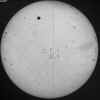 Transit of Venus photographic plate, 1882; courtesy of U.S. Naval Observatory
Library. See more historic plates and
descriptions from the USNO.
Transit of Venus photographic plate, 1882; courtesy of U.S. Naval Observatory
Library. See more historic plates and
descriptions from the USNO.
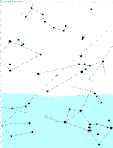 If
you could erase the daytime sky to see the background stars on transit morning,
2004 June 8, this chart shows what you might have seen. The foreground earth
appears transparent, the sky is white. Venus is near final contact;
Mercury is above the Hyades; Saturn is trailing the sun. Sun and planet
disks not to scale. If
you could erase the daytime sky to see the background stars on transit morning,
2004 June 8, this chart shows what you might have seen. The foreground earth
appears transparent, the sky is white. Venus is near final contact;
Mercury is above the Hyades; Saturn is trailing the sun. Sun and planet
disks not to scale.
 "Transit of Venus" graphic shows Venus approaching the sun's inner
limb. At third contact, the "black drop" effect ultimately
limits the accuracy of the transit timing. "Transit of Venus" graphic shows Venus approaching the sun's inner
limb. At third contact, the "black drop" effect ultimately
limits the accuracy of the transit timing.
 In practicing for the transit, Flat
Stanley recognizes that a proper solar filter must be used to keep his eyes
(and the rest of Stanley) from burning.
In practicing for the transit, Flat
Stanley recognizes that a proper solar filter must be used to keep his eyes
(and the rest of Stanley) from burning.
Education
Opportunities
For
educators, the transit of Venus is an educational opportunity in multiple disciplines.
Though
the transit is an astronomical event, educational programs can readily
incorporate math, history, geography, and other subjects.
For example, students can calculate the Astronomical Unit from their
transit timings and then apply Kepler’s Third Law to determine the distances
to all of the other planets.
Babylonian and Mesoamerican cultures
developed accurate calendars based on their observations of Venus. Other
history lessons can tap into the international timing expeditions in
context of 18th and 19th century world events.
The scientific requirement to have widespread observing sites sparked
ambitious voyages by daring explorers, yielding stories of adventure, hardship,
defeat, triumph, and discovery. These
dedicated explorers spanned the globe in
international efforts to resolve a leading scientific question of the day.
Consider the travails of Guilliame le Gentil of France, who
also discovered the Lagoon Nebula (M8)
and the companion galaxy (M32)
to the Andromeda galaxy.
Planetariums and museums in the United States broadcast
live feeds of the transit beginning the
night of June 7, 2004, in some U.S. time zones, though the transit was not visible in the
eastern U.S.
until after sunrise on June 8, 2004. NASA
(see below), the European
Southern Observatory (ESO),
and others
coordinated global transit timings that simulate the historic endeavors.
Regarding large-scale education programs, Lou Mayo wrote in Bulletin
#34 of the American Astronomical Society, 2002:
"The NASA Sun Earth Connection Education Forum in partnership with the
Solar System Exploration Forum, DPS, and a number of NASA space missions is
developing plans for an international education program centered around the
June 8, 2004 Venus transit...We will use a series of robotic observatories
including the Telescopes In Education network distributed in latitude to
provide observations of the transit that will allow middle and high school
students to calculate the A.U. through application of parallax. We will also
use Venus transit as a probe of episodes in American history (e.g. 1769:
revolutionary era, 1882: post civil war era, and 2004: modern era). Museums
and planetariums in the US and Europe will offer real time viewing of the
transit and conduct educational programs through professional development
seminars, public lectures, and planetarium shows. We are interested in
soliciting advice from the research community to coordinate professional
research interests with this program."
Lou Mayo may be reached at lmayo@pop600.gsfc.nasa.gov.
 We are pleased to announce a
Toyota TAPESTRY grant has been
awarded (March 2003) to establish a clearinghouse for transit of Venus resources. The information
will be available to multiple users, including teachers, planetarians, librarians, and other
educators. Details and content appeared as they
were
developed. We are pleased to announce a
Toyota TAPESTRY grant has been
awarded (March 2003) to establish a clearinghouse for transit of Venus resources. The information
will be available to multiple users, including teachers, planetarians, librarians, and other
educators. Details and content appeared as they
were
developed.
 The program, simply entitled Transit of Venus, is
supported by a Toyota TAPESTRY grant, which is funded by Toyota Motor Sales,
U.S.A., Inc. and is administered by the National Science Teachers Association (NSTA).
The Project Director is Art Klinger of the
Penn-Harris-Madison Planetarium in
Mishawaka, Indiana. The program, simply entitled Transit of Venus, is
supported by a Toyota TAPESTRY grant, which is funded by Toyota Motor Sales,
U.S.A., Inc. and is administered by the National Science Teachers Association (NSTA).
The Project Director is Art Klinger of the
Penn-Harris-Madison Planetarium in
Mishawaka, Indiana.
Much More About the Transit of Venus:
See http://www.transitofvenus.org
for a thorough collection of annotated links in the following categories:
NASA's transit of Venus pages begin at http://sunearth.gsfc.nasa.gov/sunearthday/2004/index_vthome.htm.
 Check out Paper Plate Ed's caveat
about believing everything you see on the Internet (including here).
Check out Paper Plate Ed's caveat
about believing everything you see on the Internet (including here).
 At the 2002
GLPA Annual Conference in Menasha,
Wisconsin,
Chuck Bueter displayed a poster about
transits of Venus. The poster's text
will appear in the 2002 GLPA Proceedings. References and other images on the 2002 GLPA poster
were used with permission of Fred Espenak, Richard Pogge, and Greg
Smye-Rumsby. Images on this page are by Chuck Bueter, unless noted otherwise.
At the 2002
GLPA Annual Conference in Menasha,
Wisconsin,
Chuck Bueter displayed a poster about
transits of Venus. The poster's text
will appear in the 2002 GLPA Proceedings. References and other images on the 2002 GLPA poster
were used with permission of Fred Espenak, Richard Pogge, and Greg
Smye-Rumsby. Images on this page are by Chuck Bueter, unless noted otherwise.
Corrections, criticism, and contributions of material are
welcome.
Contributed by Chuck Bueter.
.
|